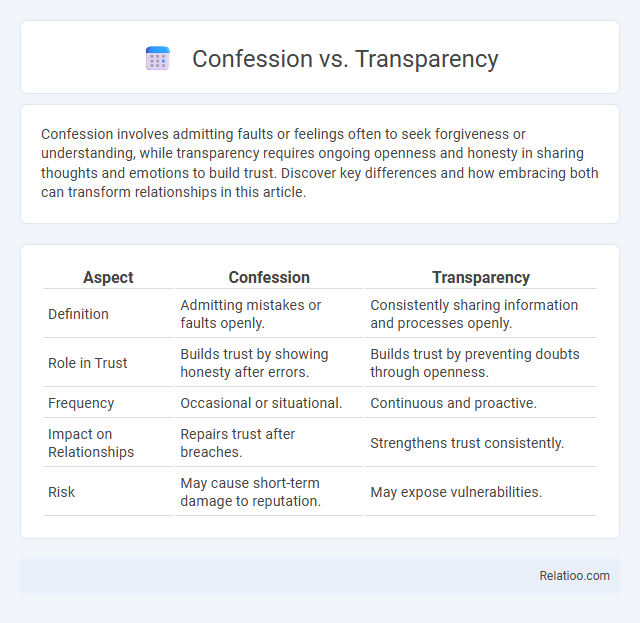Confession involves admitting faults or feelings often to seek forgiveness or understanding, while transparency requires ongoing openness and honesty in sharing thoughts and emotions to build trust. Discover key differences and how embracing both can transform relationships in this article.
Table of Comparison
| Aspect | Confession | Transparency |
|---|---|---|
| Definition | Admitting mistakes or faults openly. | Consistently sharing information and processes openly. |
| Role in Trust | Builds trust by showing honesty after errors. | Builds trust by preventing doubts through openness. |
| Frequency | Occasional or situational. | Continuous and proactive. |
| Impact on Relationships | Repairs trust after breaches. | Strengthens trust consistently. |
| Risk | May cause short-term damage to reputation. | May expose vulnerabilities. |
Understanding Confession and Transparency
Understanding confession involves acknowledging personal faults or mistakes openly to foster accountability and trust. Transparency emphasizes consistent openness and clear communication of intentions, decisions, and processes to ensure honesty and build credibility. While confession addresses specific admissions, transparency provides a broader framework for ongoing openness and information sharing.
Key Differences Between Confession and Transparency
Confession involves admitting to specific actions or faults, often implying accountability for wrongdoing, while transparency emphasizes openness and full disclosure of information without necessarily admitting fault. You maintain trust by choosing confession when acknowledging mistakes, but transparency builds confidence through proactive sharing of relevant facts and decisions. Understanding these key differences helps optimize communication strategies in personal relationships and organizational contexts.
The Role of Honesty in Confession and Transparency
Honesty serves as the foundation for both confession and transparency, enabling trust and accountability in personal and professional relationships. Confession involves acknowledging mistakes or wrongdoings with sincerity, fostering emotional relief and reconciliation. Transparency goes further by openly sharing information and intentions, promoting clarity and preventing misunderstandings.
Confession: Motivations and Impacts
Confession involves voluntarily admitting to actions or thoughts often driven by motivations such as seeking relief from guilt, obtaining forgiveness, or restoring trust. Your willingness to confess can lead to emotional catharsis, improved relationships, and personal growth, though it may also expose vulnerabilities and risk judgment. Understanding the psychological and social impacts of confession helps you navigate the balance between honesty and transparency in communication.
Transparency: Building Trust and Openness
Transparency fosters trust and openness by providing clear, honest communication that reduces misunderstandings and builds stronger relationships. Unlike confession, which often involves admitting faults after the fact, transparency emphasizes proactive sharing of information to maintain accountability and credibility. Businesses and leaders who prioritize transparency create environments where stakeholders feel informed, respected, and more engaged.
Psychological Effects of Confession vs Transparency
Confession involves admitting wrongdoing or hidden thoughts, which can lead to psychological relief by reducing guilt and anxiety through self-disclosure. Transparency, characterized by open and honest communication without concealing information, fosters trust and emotional safety, enhancing interpersonal relationships and reducing stress. Psychological effects of confession often center on internal catharsis, whereas transparency emphasizes mutual understanding and external validation, impacting mental health differently based on the context and nature of the disclosure.
Social and Cultural Perspectives
Confession in social contexts often involves admitting personal faults within cultural frameworks that value privacy or honor, whereas transparency emphasizes openness and accountability, reflecting contemporary demands for trust in institutions and relationships. Cultural perspectives influence whether confession is seen as a path to redemption or a potential source of shame, while transparency challenges traditional norms by promoting visibility and dialogue. The balance between confession and transparency shapes social dynamics, impacting communal cohesion and individual identity across diverse cultures.
Ethical Considerations in Disclosure
Ethical considerations in disclosure involve balancing confession, transparency, and selective revealing of information to maintain trust and integrity. Confession requires acknowledging wrongdoing honestly, fostering accountability, while transparency emphasizes openness but may risk exposing sensitive data. Ethical disclosure demands assessing the impact on stakeholders, prioritizing honesty without compromising privacy or causing harm.
Practical Scenarios: When to Confess vs When to Be Transparent
Confessing is appropriate in situations involving personal mistakes or ethical breaches where admitting fault can restore trust and facilitate healing, such as apologizing for wrongdoing in relationships or workplace errors. Transparency is crucial when sharing information openly to build credibility and foster collaboration, especially in business settings where stakeholders require clear insights into decisions and processes. Practical application depends on context: confess to acknowledge responsibility and seek forgiveness, whereas maintain transparency to promote honesty and prevent misunderstandings in ongoing communications.
Conclusion: Choosing the Right Approach
Choosing the right approach between confession, transparency, and traditional confession depends on the context and desired outcome; transparency fosters trust and clarity in professional and personal relationships by providing consistent, honest information. Confession, often emotional and situational, helps in addressing guilt or mistakes directly, promoting healing and accountability. Balancing transparency with timely confession ensures integrity while maintaining openness, ultimately strengthening relationships and facilitating effective communication.

Infographic: Confession vs Transparency
 relatioo.com
relatioo.com